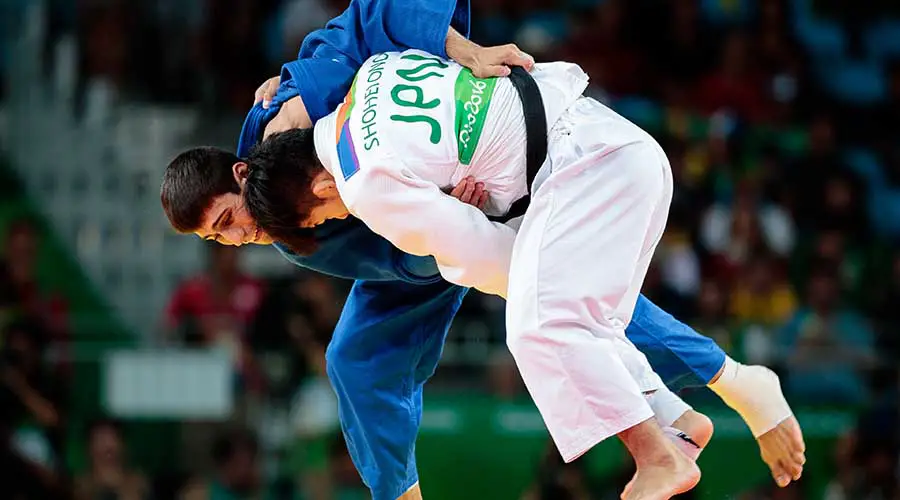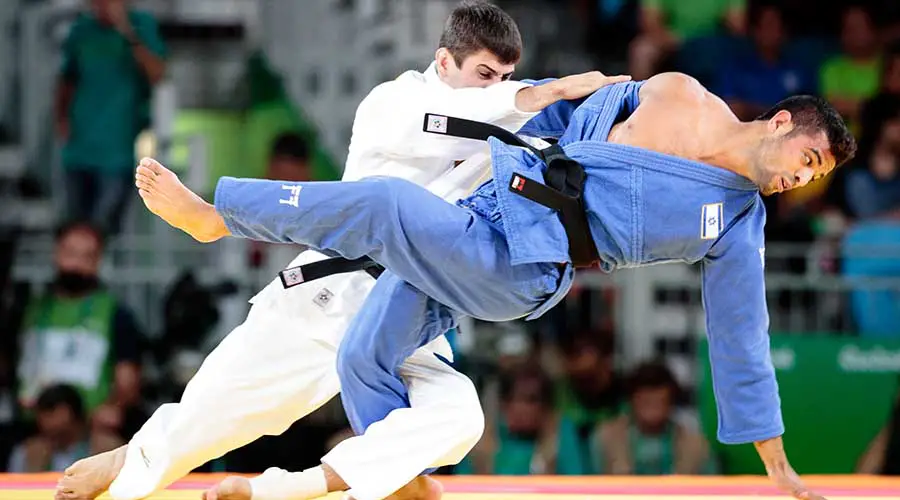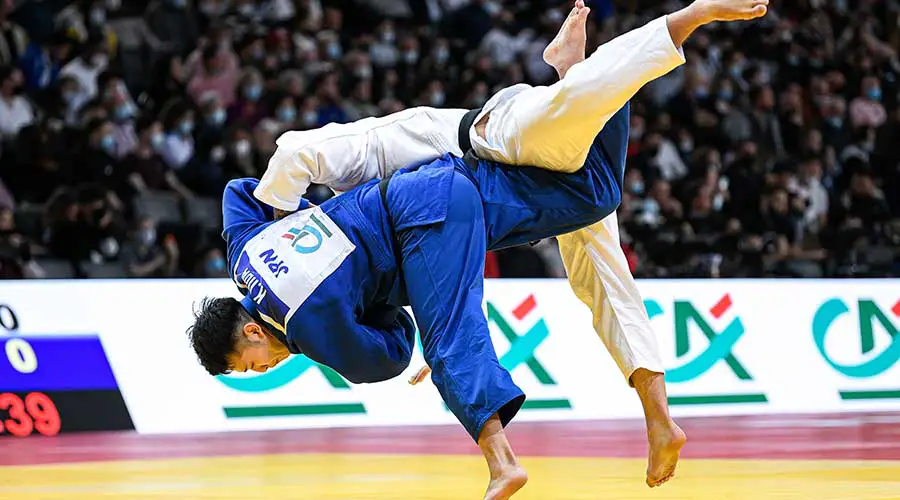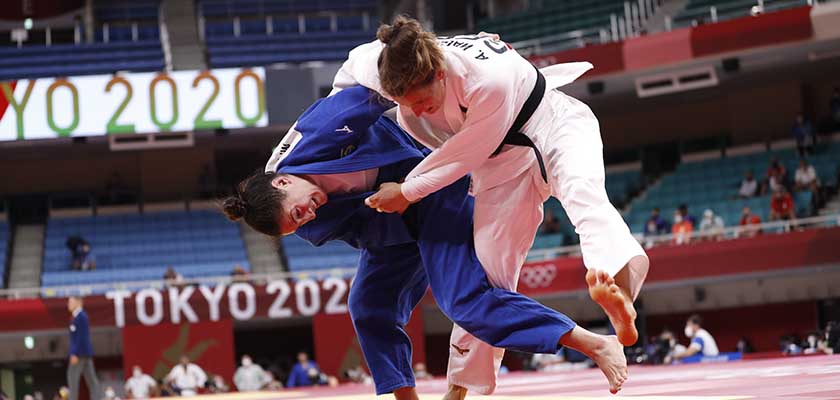Judo is an Olympic sport that involves hand-to-hand fighting techniques such as throws, throws, immobilisations, chokes and locks. The aim is to knock your opponent to the ground or force them to give up.
To this end, there are rules that regulate the points system, infractions, the dimensions of the mat and other competitive aspects. In this way, the sport becomes fair, guaranteeing the integrity and safety of practitioners.
In this complete and up-to-date guide, we’ll introduce you to the main rules of judo and how they influence the outcome of matches.
We’ll go through the forms of scoring, duration of fights, penalties, forbidden blows, permitted equipment and much more.
Check it out 👇
What does a judo mat look like?
Judo fights are held on a square-shaped mat. The total area of the arena is 14 metres wide and 14 metres long.
This total perimeter is divided into two areas: the combat area (8m wide by 8m long), where the judoka can apply their blows, and the safety area (3 metres wide), which is used for escapes.
If a technique is applied in the safety area, the point is cancelled, as strikes can only be made in the combat area.
The tatami is soft and non-slip, guaranteeing safety when falling to the ground and, above all, fixation, preventing the judoka from slipping when fighting.
Judo equipment
The judogi is the uniform used in judo. It consists of a jacket (wagi), trousers (shitabaki) and a sash (obi). In the case of women’s wrestling, women must also wear a white T-shirt under the wagi.
Another important element of the fighters’ attire is the identification patch, usually sewn onto the judogi.
These patches identify important elements such as the federation, country of origin, competition emblem, among others.
The judogi is the uniform used in judo. It consists of a jacket (wagi), trousers (shitabaki) and sash (obi). In the case of women’s wrestling, women must also wear a white T-shirt under the wagi.
Another important element of the fighters’ attire is the identification patch, usually sewn onto the judogi.
These patches identify important elements such as the federation, country of origin, competition emblem, among others.
How does a judo fight work?

Judo fights last four minutes. In the meantime, the fighter needs to use combat techniques to score points and win the fight.
The blows are divided into projections, throws, immobilisations and chokes, both standing and on the ground. To do this, the judoka uses different parts of the body, such as the feet, legs, hands, arms, hips and back.
The techniques require strength, balance and positioning, and it is permissible to hold both the opponent’s collar and sleeves.
Judo scoring
When a blow is executed perfectly, the fighter scores an Ippon, which is equivalent to one point. This is enough to automatically win the match.
To score an Ippon, the judoka needs to use a technique with strength, balance, speed and synchronisation. In addition, the opponent must fall to the mat with both backs against the ground.
There is also the Waza-ari, which is an “almost perfect” technique. It’s worth half a point and doesn’t end the match instantly.
However, if the fighter lands two Waza-ari before the time runs out, then victory is declared, as two Waza-ari are equivalent to an Ippon.
It’s worth noting that it’s possible to score Ippon or Waza-ari through submissions, chokes and ground holds.
When a fighter manages to immobilise his opponent for 10 to 19 seconds, he scores a Waza-ari. If the immobilisation reaches 20 minutes, an Ippon is scored.
That’s if the opponent doesn’t give up. If the opponent gives a pat to signal surrender, the fight is over regardless of the time accumulated.
Another way to win a judo match is to have a Waza-ari until the clock runs out. Even if you don’t score an Ippon, the victory goes to whoever scored the most points, meaning that in this context, just one Waza-ari is enough.
When the fight ends in a draw with no points, an infinite overtime period called the Golden Score is played. In this, the judoka who scores the first point (regardless of whether it’s a Waza-ari or Ippon) wins the match.
Finally, there is victory by accumulation of infractions, which in judo are called Shido. When the opponent breaks the rules of the sport and is penalised three times during the fight, they automatically lose the match.
Judo infractions

There are two types of punishment in judo. The simplest is called Shido. It is applied to a judoka who avoids the fight with excessive passivity, feigns attacks in order to deceive his opponent or holds his opponent’s trousers.
Other actions liable to Shido are: holding the opponent’s sleeve defensively for more than 5 seconds, messing up the equipment without the referee’s authorisation, deliberately interlacing the fingers of the hand for more than 5 seconds and putting the finger inside the opponent’s collar or trousers.
If a judoka receives three Shidos during a fight, he is automatically eliminated. Their opponent is then declared the winner of the match.
The second form of punishment in judo is called Hansoku-make. It is more severe, meaning that it only takes one sanction to be disqualified.
The following are liable to a Hansoku-make: accumulating three Shidos, lifting an opponent who was on the ground to attack him again, applying forbidden blows (to the neck, spine or that disrespect the spirit of judo) or applying techniques below the opponent’s waist line.
Other judo rules
Greetings: Before the fight begins, the judoka greet each other and then wave to the referee and his assistants;
Etiquette and respect: Respect is fundamental in judo. Competitors must act in a courteous and respectful manner throughout the fight;
Refereeing: Referees and assistants are responsible for interpreting blows and scoring points, handing out penalties and determining the end of the fight.
Judo weight classes (women)
- Extra Lightweight: up to 48kg
- Half Lightweight: up to 52 kg
- Lightweight: up to 57 kg
- Half Middleweight: up to 63 kg
- Middleweight: up to 70 kg
- Half Heavyweight: up to 78 kg
- Heavyweight: over 78 kg
Judo weight classes (men)

- Extra Lightweight: up to 60kg
- Half Lightweight: up to 66 kg
- Lightweight: up to 73 kg
- Half Middleweight: up to 81 kg
- Middleweight: 90 kg
- Half Heavyweight: up to 100 kg
- Heavyweight: over 100 kg
Now you know all the rules of judo and are ready to watch the sport’s fights! Did you like this content? Let us know what you think in the comments!
Visit us every day for more fresh content on Olympic sports, games, esports, betting and lotteries 👊



